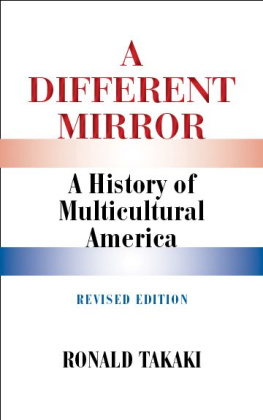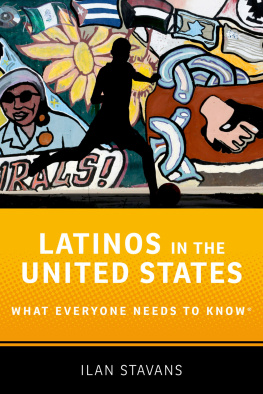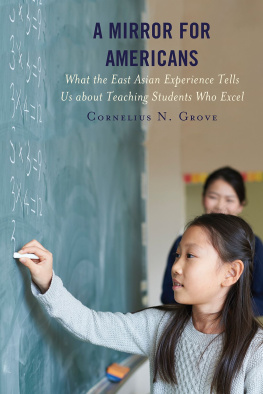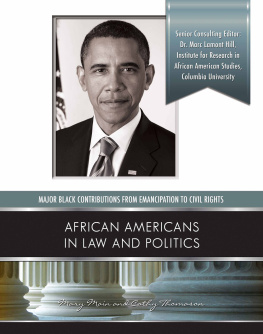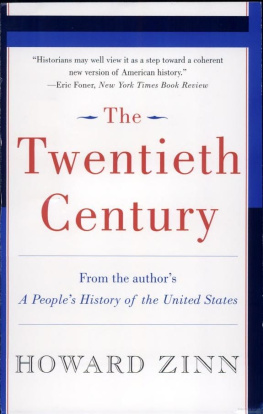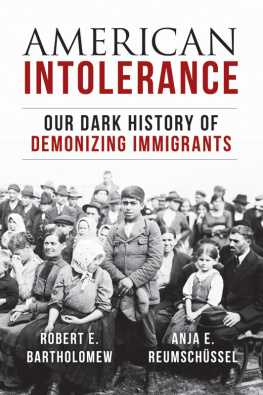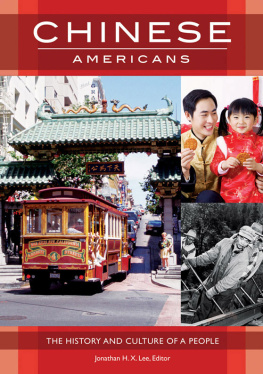
A
DIFFERENT
MIRROR
A History of
Multicultural America
REVISED EDITION
Ronald Takaki
Copyright 1993, 2008 by Ronald Takaki
All rights reserved. Except as permitted under the U.S. Copyright Act of 1976, no part of this publication may by reproduced, distributed, or transmitted in any form or by any means, or stored in a database or retrieval system, without the prior written permission of the publisher.
First revised edition, December 2008 Originally published in hardcover by Little, Brown and Company, June 1993
This book is dedicated to
my wife,
CAROL,
for our forty-nine years of friendship,
our joyous journey through a lifetime of scholarship,
and our ceaseless collaboration
in recovering and writing American
historys missing chapters.
Acclaim for Ronald Takakis
A DIFFERENT MIRROR
In our increasingly diverse society, the issues of race, ethnicity, and religion are often at the forefront of American consciousness, and always in the backs of our minds, shaping our own identity and our views of others. They reverberate in our voting booths, town halls classrooms, and popular culture. In this timely update of A Different Mirror: A History of Multicultural America, Professor Ronald Takaki examines the challenges we face in reconciling our differences and forming a secure, sustainable future for our country. Now more than ever, its essential that we understand and embrace our diversity if we are to grow together as a nation.
President Bill Clinton
A valuable contribution to the discussion of America as a multicultural society.
Boston Globe
Takakis book is nothing less than an attempt to a view all of American history from a multiculrual perspective. It is a laudable efforthumane, well informed, accessible, and often incisive. It is clearly not intended to divide American but rather to teach them to value the nations inescapable diversity.
New York Times Book Review
A groundbreaker. Its fascinating to watch Takaki weave these multifaceted strands into a single narrative text.
San Francisco Chronicle
While Takakis subtitle is a history of multicultural America, his book is also a manifesto for the future.
New York Review of Books
A Different Mirror demonstrates that employing a multicultural approach to American history is a necessary first step toward the binding together of our disunited nation.
Detroit Free Press
A Different Mirror advances a truly humane sense of American possibility.
Henry Louis Gates, Jr.
Also by Ronald Takaki
A Pro-Slavery Crusade: The Agitation to Reopen the African Slave Trade
Violence in the Black Imagination: Essays and Documents
Iron Cages: Race and Culture in Nineteenth-Century America
Pau Hana: Plantation Life and Labor in Hawaii
From Different Shores: Perspectives on Race and Ethnicity in America
Strangers from a Different Shore: A History of Asian Americans
Hiroshima: Why American Dropped the Atomic Bomb
A Large Memory: A History of Our Diversity with Voices
Debating Diversity: Clashing Perspectives on Race and Ethnicity in America
Double Victory: A Multicultural History of America in World War II
CONTENTS
A DIFFERENT MIRROR
The Making of
Multicultural America
I HAD FLOWN from San Francisco to Norfolk and was riding in a taxi. The driver and I chatted about the weather and the tourists. The sky was cloudy, and twenty minutes away was Virginia Beach, where I was scheduled to give a keynote address to hundreds of teachers and administrators at a conference on multicultural education. The rearview mirror reflected a white man in his forties. How long have you been in this country? he asked. All my life, I replied, wincing. His question was one I had been asked too many times, even by northerners with Ph.D.s. I was born in the United States, I added. He replied: I was wondering because your English is excellent! Then I explained: My grandfather came here from Japan in the 1880s. My family has been here, in America, for over a hundred years. He glanced at me in the mirror. To him, I did not look like an American.
Suddenly, we both became uncomfortably conscious of a divide between us. An awkward silence turned my gaze from the mirror to the passing scenery. Here, at the eastern edge of the continent, I mused, was the site of the beginning of multicultural America. Our highway crossed land that Sir Walter Raleigh had renamed Virginia in honor of Elizabeth I, the Virgin Queen. Taking lands from the Indians, the English colonizers founded Jamestown in 1607, and six years later they shipped the first four barrels of tobacco to London. Almost immediately, tobacco became an immensely profitable export crop, and the rise of the tobacco economy generated an insatiable demand for Indian land as well as for labor from England, Ireland, and Africa. In 1619, a year before the arrival of the Pilgrims at Plymouth Rock, a Dutch slave ship landed the first twenty Africans at Jamestown. Indeed, history saturated the surrounding landscape.
Questions like the one that my taxi driver asked me are always jarring. But it was not his fault that he did not see me as a fellow citizen: what had he learned about Asian Americans in courses called U.S. history ? He saw me through a filterwhat I call the Master Narrative of American History. According to this powerful and popular but inaccurate story, our country was settled by European immigrants, and Americans are white. Race, observed Toni Morrison, has functioned as a metaphor necessary to the construction of Americanness : in the creation of our national identity, American has been defined as white. Not to be white is to be designated as the Otherdifferent, inferior, and unassimilable.
The Master Narrative is deeply embedded in our mainstream culture and can be found in the scholarship of a long list of preeminent historians. The father of the Master Narrative was Frederick Jackson Turner. In 1893, two years after the Census Bureau announced that Americans had settled the entire continent and that the frontier had come to an end, Turner gave a presentation at the meeting of the American Historical Association. Entitled The Significance of the Frontier in American History, his paper would make him famous. Turner would become the dean of American history, his influence spanning generations of historians to come.
In what would be hailed as the frontier thesis, Turner declared that the end of the frontier marked the closing of a great historic movementthe colonization of the Great West. He explained that the frontier had been the meeting point between savagery and civilization. At this intersection, the Europeans had been Americanized by the wilderness. Initially, the wilderness masters the colonist. It finds him a European in dress, industries, tools, modes of travel and thought. It takes him from the railroad car and puts him in a birch canoe. It strips off the garments of civilization, and arrays him in the hunting shirt and moccasin. It puts him in the log cabin of the Cherokee and Iroquois. Before long he has gone to planting Indian corn and plowing with a sharp stick; he shouts the war cry and takes the scalp in orthodox
In Turners footsteps came Harvard historian Oscar Handlin. In his 1945 prizewinning study The Uprooted, Handlin presentedto use the books subtitle

